After our easy day in Oxford, we spent another hiking day exploring more of the Cotswolds.
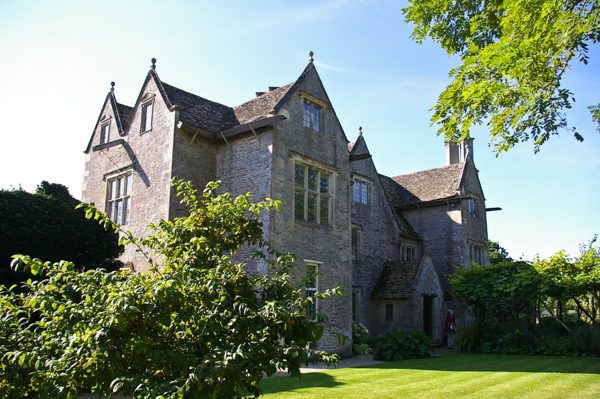
In 1878 William Morris and his family moved to Kelmscott Manor, which he had purchased as a country retreat.
Morris was a complex individual with complicated relationships living in a time of artistic and social ferment. I can't begin to write a brief summary here. Further study is recommended.
For information on his designs, check out the Morris & Co. website.
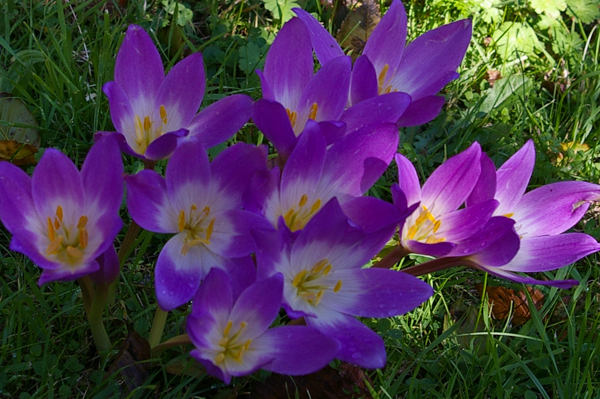 Morris sought much of his inspiration in nature – including in
his own garden. While waiting for the time appointed
for the house tour, we prowled around the garden. These autumn crocus
were bright enough to hurt your eyes!
Morris sought much of his inspiration in nature – including in
his own garden. While waiting for the time appointed
for the house tour, we prowled around the garden. These autumn crocus
were bright enough to hurt your eyes! 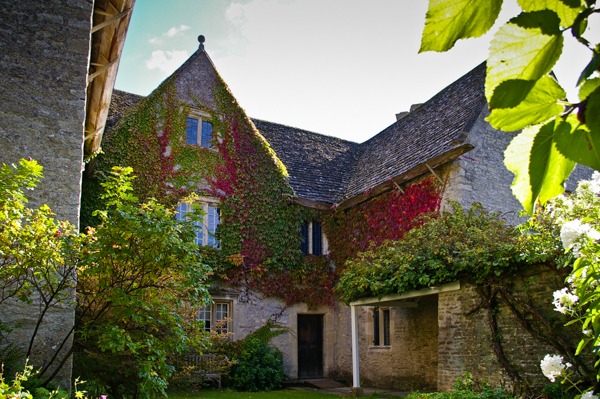 The back door of the house was a prettier entry that the front, in my
opinion, but it was hard to get a good image due to a huge mulberry
tree planted at the optimum spot for a picture.
The back door of the house was a prettier entry that the front, in my
opinion, but it was hard to get a good image due to a huge mulberry
tree planted at the optimum spot for a picture.We were not allowed to take pictures inside. The house and its furnishings were original to the Morris family. May Morris, the younger daughter of William and Jane Morris, lived in the house until she died and then willed it to Oxford with very restrictive covenants. The will was broken and the property was transferred to the Society of Antiquaries of London, which was able to raise funds to conserve the buildings and contents properly.
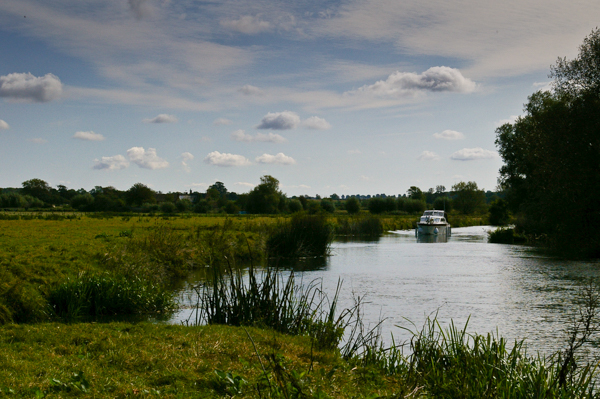 The Thames River flows a short distance from the house. Numerous
pleasure boats were out on this Saturday morning. Several tied up here
either to visit Kelmscott Manor or the local pub, which looked to be
a good one, but it was a bit early to curl up with a pint.
The Thames River flows a short distance from the house. Numerous
pleasure boats were out on this Saturday morning. Several tied up here
either to visit Kelmscott Manor or the local pub, which looked to be
a good one, but it was a bit early to curl up with a pint. 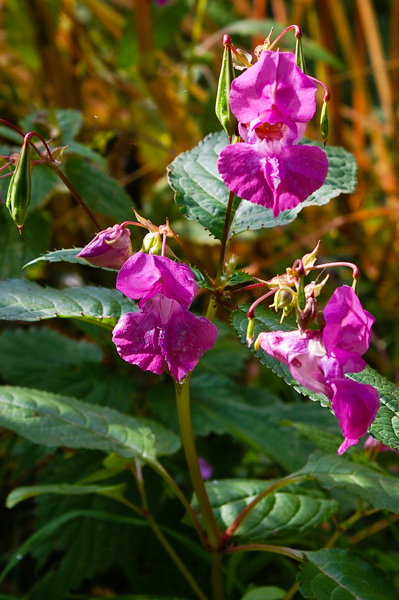 Morris also found inspiration in the flowers of the hedgerow.
They say a wildflower is a weed that you have a name for. Since I have
no name for this one, I guess it's just a weed, but a pretty one.
Morris also found inspiration in the flowers of the hedgerow.
They say a wildflower is a weed that you have a name for. Since I have
no name for this one, I guess it's just a weed, but a pretty one.
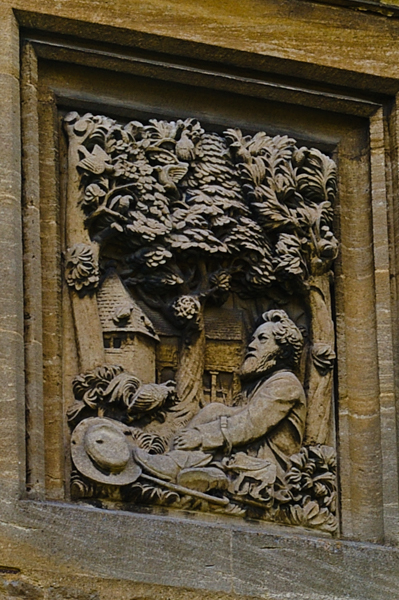 One of the village houses had this carved inset of Morris built into
the wall. I don't know how it may have been related to him. The
owners may have been friends, associates, or simply great admirers.
One of the village houses had this carved inset of Morris built into
the wall. I don't know how it may have been related to him. The
owners may have been friends, associates, or simply great admirers.
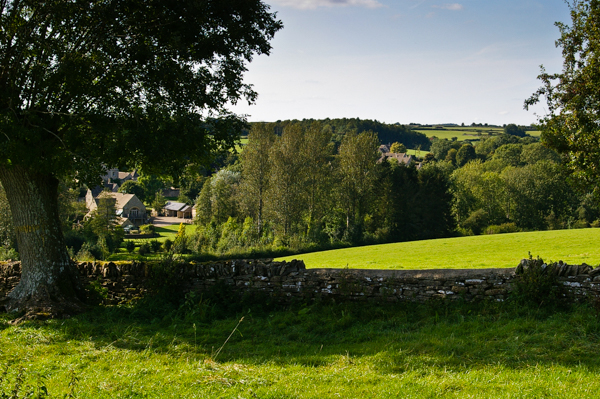 After leaving Kelmscott, we took the bus to Bibury, where we continued
our investigations of pub lunches (and pints) and then spent the afternoon
walking more-or-less along the Coln River to Fossebridge.
After leaving Kelmscott, we took the bus to Bibury, where we continued
our investigations of pub lunches (and pints) and then spent the afternoon
walking more-or-less along the Coln River to Fossebridge.The village in the valley here is Coln Rogers. We are walking beside a field that is used for equestrian events. The wall shown here has an inset jump as shown by the lack of coping stones. There were many other jumps here and there and specialized material around to construct others. Coln Rogers also had a higher concentration of horses in the various fields we passed. Can't help it – I notice horses and related activities.
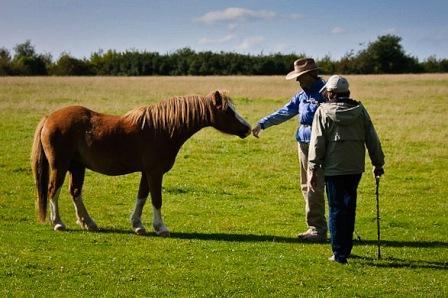 This was the only chance I had to get up close and personal with an
equine. This little guy was very friendly.
This was the only chance I had to get up close and personal with an
equine. This little guy was very friendly.Photograph courtesy of Bill Beuther.
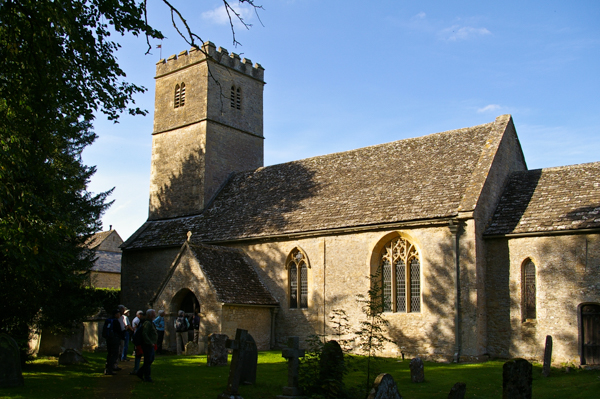 Coln Rogers is a
Thankful Village
(opens in new tab),
meaning it had no fatalities among the men who served in WWI. There
is a little plaque in the village church, St. Andrews, with the names
of those who served ... and returned home alive.
Coln Rogers is a
Thankful Village
(opens in new tab),
meaning it had no fatalities among the men who served in WWI. There
is a little plaque in the village church, St. Andrews, with the names
of those who served ... and returned home alive.The little church has another distinction: it is a Saxon church dating from the 11th century. There have been a number of changes since, such as the addition of the tower and porch, but there are some original elements.
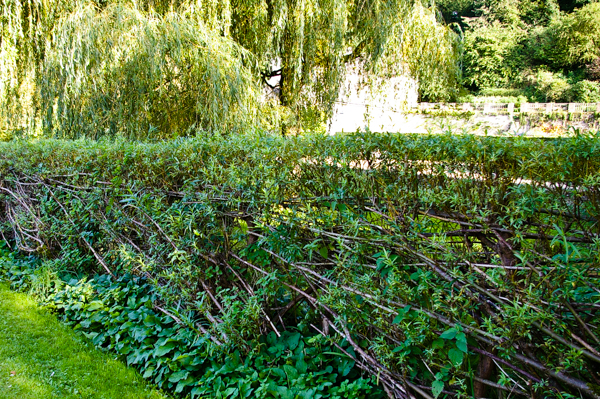 This isn't a wall; it is a hedge.
One of our evening lecturers explained how these
hedges are made. They start out the normal way as shrubs with vertical branches.
When they reach a certain height, the
base of the shrub is cut partially through and the entire plant is laid
on its side. The branches are interlaced with the branches from neighboring shurbs, thereby forming a sturdy hedge. Over time the branches fill
out making it an effective barrier.
This isn't a wall; it is a hedge.
One of our evening lecturers explained how these
hedges are made. They start out the normal way as shrubs with vertical branches.
When they reach a certain height, the
base of the shrub is cut partially through and the entire plant is laid
on its side. The branches are interlaced with the branches from neighboring shurbs, thereby forming a sturdy hedge. Over time the branches fill
out making it an effective barrier. 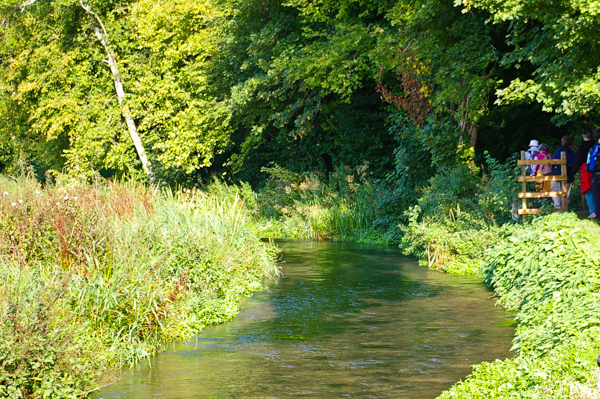 One of the segments where the path followed the Coln "river"
quite closely. The river is a tributary of the Thames.
One of the segments where the path followed the Coln "river"
quite closely. The river is a tributary of the Thames. 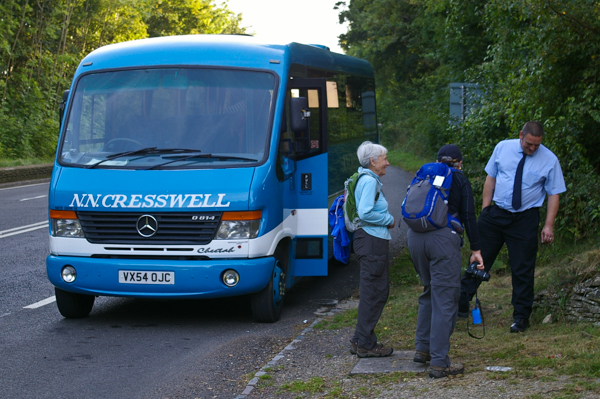 Since we were so dependent on our various buses and their drivers, it
seemed appropriate to include a picture of one. Occasionally we
used a larger bus, but the small size of our group enabled us to
use the smaller buses necessary on the prevalent narrow
roads.
Since we were so dependent on our various buses and their drivers, it
seemed appropriate to include a picture of one. Occasionally we
used a larger bus, but the small size of our group enabled us to
use the smaller buses necessary on the prevalent narrow
roads. 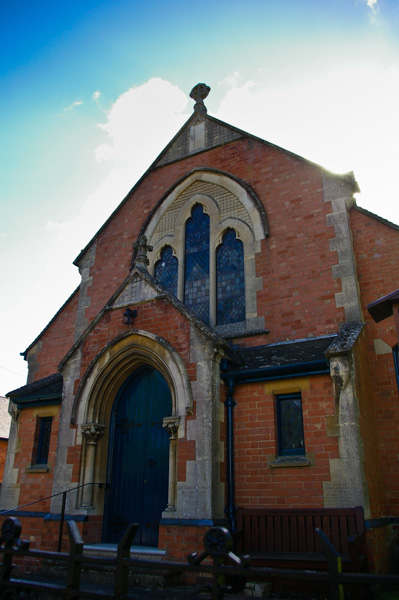
The following day was Sunday and raining. We were tired and averse to getting drenched so Jim & I passed on the hike. I went to church at the Mickleton Methodist chapel just a few doors from the hotel (the picture was taken earlier on a clear day).
The congregants were friendly and it was a lovely experience. I had not attended a Methodist service before, but it was very like the Presbyterian ones that I'm used to. One of the greeters characterized it as a "hymn sandwich" and the description was apt with no fewer than five hymns during the service. As in other English churches I've attended the hymnbook had no music – only words. Three of the tunes were completely unfamiliar, but I managed to cope.
Afterwards I rejoined Jim for further investigation into village pub life. We were happy to find that the Butchers Arms had a roaring fire on that rainy and chilly day.
The next morning our group was packed up and ready to load into the bus for our trip to Cornwall via Wells.
Click the "back" button to continue with us.